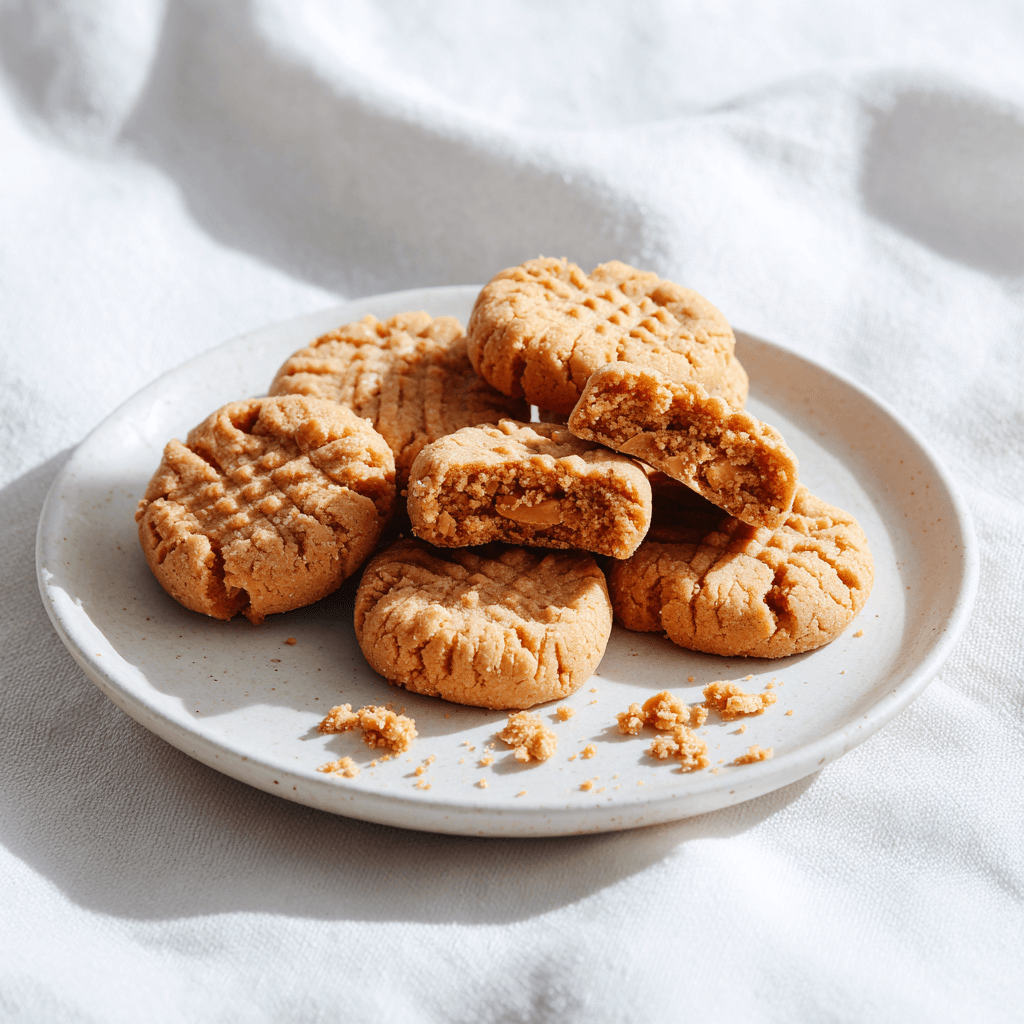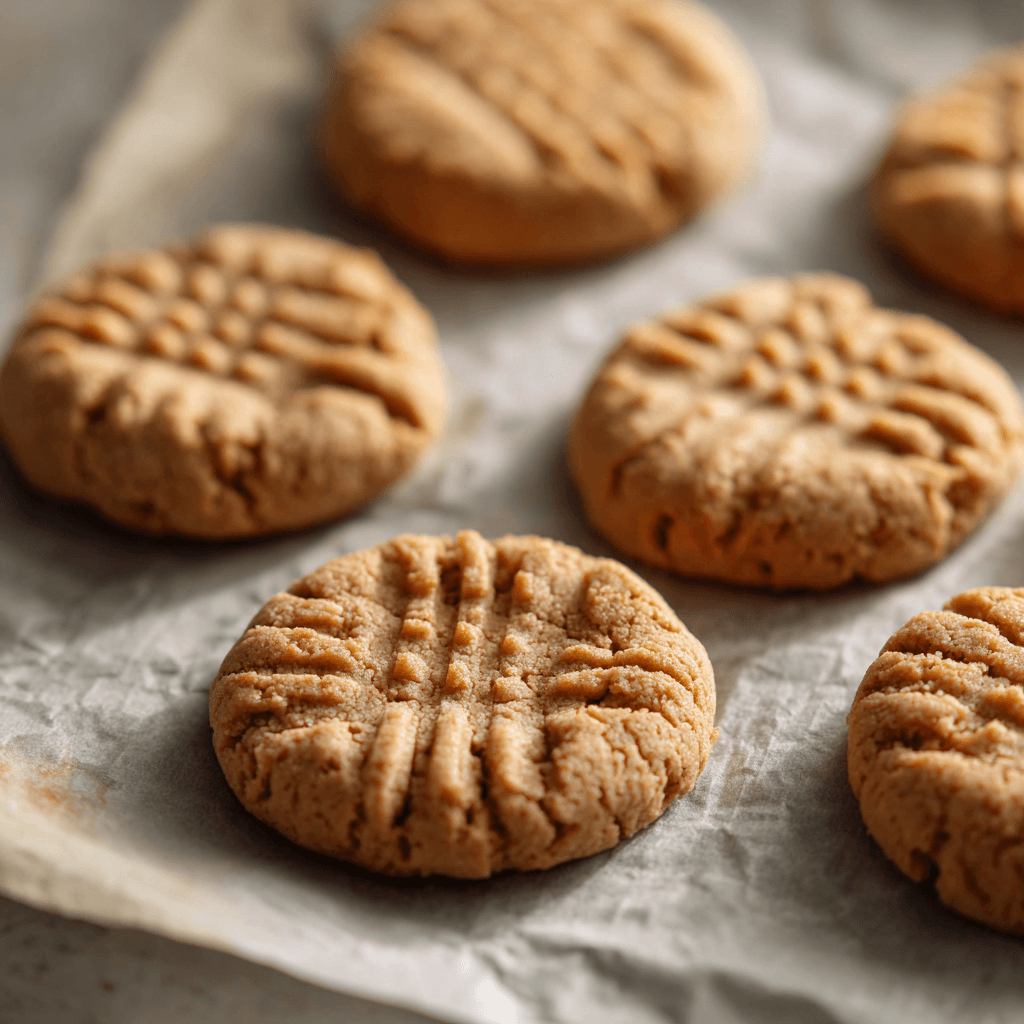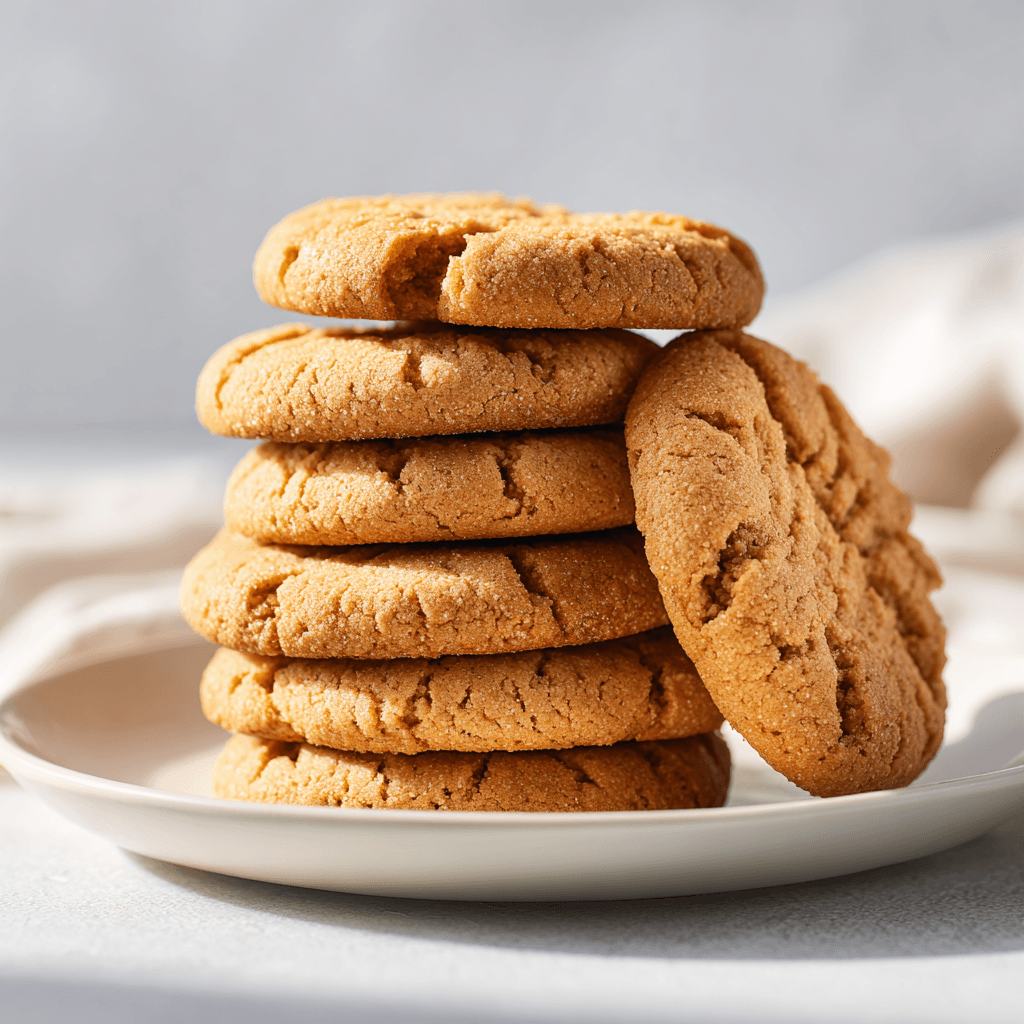Craving soft, chewy cookies but don’t have eggs on hand? These peanut butter cookies no egg are the answer. They’re rich, nutty, and perfectly balanced between chewy and tender. Whether you’re baking for someone with an egg allergy, following a vegan lifestyle, or simply ran out of eggs, this recipe proves you don’t have to sacrifice taste or texture.
With simple pantry staples and smart substitutions, you’ll have warm, homemade cookies ready in no time. Let’s dive into what makes these no-egg peanut butter cookies so satisfying.
Table of Contents
Why Make Peanut Butter Cookies Without Eggs?

When you bake peanut butter cookies no egg, you’re not just working around missing ingredients—you’re opening the door to options that suit different lifestyles and needs.
Common Reasons to Skip Eggs
- Egg allergy: Many families deal with food allergies, and baking without eggs keeps treats safe for everyone.
- Vegan option: Removing eggs makes these cookies a go-to for plant-based eaters.
- Out of eggs: Sometimes you simply don’t have eggs in the pantry, but that shouldn’t stop cookie cravings.
If you’re looking for more allergy-friendly treats, check out our vegan cheesecake recipe or mango chia pudding, both of which skip common allergens.
The Role of Eggs in Cookies
Eggs aren’t just a binder—they play several critical roles in cookie baking:
- Binding function: Eggs hold ingredients together, giving cookies structure.
- Moisture retention: Yolks add fat and richness, helping cookies stay soft.
- Protein and fat balance: The protein helps set the cookie, while the fat adds tenderness.
- Texture control: Eggs impact whether cookies bake up chewy, dense, or cakey.
How Substitutes Work
When you use egg alternatives, you’re replacing these functions with other ingredients. Substitutes mimic:
- Viscosity and binding: Flax or chia gels help dough stick together.
- Moisture balance: Applesauce, yogurt, or banana add soft, chewy texture.
- Fat content: Oils or nut butters replace the richness of eggs.
This flexibility lets you create soft eggless PB cookies that taste just as good as the classic ones.
Best Egg Substitutes & Binding Agents for Peanut Butter Cookies
When baking peanut butter cookies no egg, the key is choosing the right binder. Each substitute has pros, cons, and unique effects on texture. Let’s look at the best options.
Flax “Egg” (Ground Flax + Water)
- How it works: Ground flaxseed mixed with water creates a gel-like consistency (mucilage) that mimics egg binding.
- Ratio: 1 tablespoon ground flax + 3 tablespoons water = 1 egg.
- Pros: Nutty flavor, strong binder, adds fiber.
- Cons: Can make cookies slightly denser.
Chia “Egg” (Chia Seed + Water)
- How it works: Chia seeds hydrate into a thick gel, perfect for holding dough together.
- Ratio: 1 tablespoon chia seeds + 3 tablespoons water = 1 egg.
- Pros: Neutral flavor, great binder, boosts nutrition.
- Cons: May add a slight crunch if not fully ground.
Aquafaba (Chickpea Brine)
- How it works: The liquid from canned chickpeas whips into a foamy, egg-like binder.
- Ratio: 3 tablespoons aquafaba = 1 egg.
- Pros: Excellent for chewy texture, light results.
- Cons: Requires draining chickpeas, flavor may vary.
Applesauce / Mashed Banana / Yogurt / Silken Tofu
- Applesauce: Adds moisture and mild sweetness. (¼ cup = 1 egg)
- Banana: Creates a soft, chewy texture with a hint of banana flavor. (¼ cup = 1 egg)
- Yogurt (dairy-free or regular): Creamy binder that keeps cookies moist. (¼ cup = 1 egg)
- Silken tofu: Neutral taste, adds density and structure. (¼ cup = 1 egg)
Oil + Water, Vegan Butter + Milk
- Oil + water: Mimics the fat of eggs while keeping cookies tender.
- Vegan butter + nondairy milk: Plant-based combo that balances fat and moisture.
- Pros: Simple, pantry-friendly.
- Cons: Easy to make cookies too oily if overused.
Combination / Hybrid Methods
Sometimes the best results come from blending binders:
- Flax + applesauce = chewy yet soft.
- Aquafaba + oil = light but tender.
- Banana + yogurt = dense, moist, and rich.
Want more peanut butter dessert inspiration? Try my peanut butter oatmeal cookies, another easy egg-free option.
How To Make Eggless Peanut Butter Cookies

Making peanut butter cookies no egg is simple once you know the right substitutions. Here’s everything you need:
Ingredients & Metric / Imperial Conversions
For about 18 cookies:
- 1 cup (250 g) natural peanut butter (creamy or chunky)
- ¾ cup (150 g) granulated sugar
- ¼ cup (50 g) brown sugar
- 1 ¼ cups (155 g) all-purpose flour (use gluten-free flour if needed)
- ½ tsp baking powder
- ½ tsp baking soda
- ¼ tsp salt
- 1 tsp vanilla extract
- 3 tbsp nondairy milk (or regular milk if not vegan)
- 1 flax egg (1 tbsp flaxseed + 3 tbsp water) or another binder of choice
If you like experimenting, try these oatmeal protein pancakes or gluten-free pancakes recipe for more egg-free baking inspiration.
Step-by-Step Instructions
- Prepare binder: Mix flaxseed and water. Let sit 5 minutes to thicken.
- Cream: In a bowl, beat peanut butter, sugars, and vanilla until smooth.
- Mix: Add flax egg and nondairy milk, stirring until combined.
- Fold: Add dry ingredients (flour, baking powder, soda, salt). Mix until dough holds together.
- Chill: Refrigerate dough for 20–30 minutes for easier scooping.
- Scoop: Roll dough into balls. Place on a parchment-lined baking sheet.
- Flatten: Press gently with a fork in a crisscross pattern.
- Bake: 350°F (175°C) for 10–12 minutes, until edges are golden.
- Cool: Allow to rest on the sheet for 5 minutes before transferring to a rack.
For the main primary recipe, check out our step-by-step guide to Peanut Butter Cookies that covers everything from mixing to baking
Baking Tips & Timing
- Preheat oven before baking for even results.
- Line cookie sheet with parchment paper to prevent sticking.
- Rotate tray halfway through for uniform browning.
- Spacing: Leave 2 inches between cookies to prevent spreading.
- Check doneness: Edges should be golden, center just set.
Pro tip: Do not overbake—cookies will continue to firm as they cool.
Variations & Dietary Adaptations
One of the best parts about making peanut butter cookies no egg is how adaptable they are. Here are some creative twists:
Vegan / Dairy-Free Version
- Use plant-based butter instead of dairy butter.
- Swap milk with almond, oat, or soy milk.
- Choose vegan binders like flax egg or aquafaba.
If you’re into plant-based baking, try my dairy-free pancake recipe for another easy swap.
Gluten-Free / Grain-Free Version
- Substitute all-purpose flour with a gluten-free baking blend.
- Almond flour or oat flour can also work, but texture will be denser.
- Always check labels for certified gluten-free ingredients.
Nut-Free / Allergy-Safe Version
- Replace peanut butter with sunflower seed butter or soy nut butter.
- These alternatives taste rich and nutty but are allergy-friendly.
- Great for school-safe treats.
For another nut-free sweet, check out my banana pudding recipe—a Southern classic without peanut worries.
Troubleshooting Common Issues
Even the best peanut butter cookies no egg can run into problems. Here’s how to fix the most common ones:
Why did my cookies spread too much?
- Dough may be too warm — chill for 30 minutes before baking.
- Too much liquid or fat — reduce nondairy milk slightly.
- Use parchment instead of greased sheets.
Why are my cookies crumbly or falling apart?
- Not enough binder — add an extra flax egg or 2 tbsp applesauce.
- Overbaking dries out the cookies.
- Try silken tofu or yogurt for extra moisture.
What to do if dough is too sticky or too dry?
- Too sticky: Add 1–2 tbsp flour and chill.
- Too dry: Mix in 1–2 tsp nondairy milk or oil.
- Always measure flour with the spoon-and-level method.
For more baking guidance, you can also look at my sourdough discard cinnamon rolls — where dough texture is everything.
Storage, Freezing & Reheating
Keeping your peanut butter cookies no egg fresh doesn’t take much effort. At room temperature, they stay soft in an airtight container for three to four days. If you prefer longer storage, the fridge keeps them fresh for up to a week.
Freezing works just as well. For dough, scoop portions onto a tray, freeze until firm, then transfer to a bag or container. You can bake them straight from the freezer—just add a couple of extra minutes to the bake time.
Baked cookies also freeze beautifully for up to two months. Make sure they’re cooled, then layer them between parchment to avoid sticking.
When it’s time to enjoy, a quick reheat brings them back to life. Five minutes in a 300°F (150°C) oven restores crisp edges, while 10–15 seconds in the microwave softens the centers. Thaw frozen cookies at room temperature first for the best texture.
Frequently Asked Questions
What can I use to replace an egg in peanut butter cookies?
You can use a flax egg, chia egg, aquafaba, applesauce, or mashed banana. Each option binds the dough while keeping cookies soft.
What can I put in cookies if I don’t have eggs?
Common swaps include yogurt, silken tofu, or a blend of oil and nondairy milk. These keep the dough moist and chewy.
What happens if you don’t add eggs to cookies?
Without eggs, cookies may be crumbly or dry unless you add a proper binder. With the right substitute, they bake up chewy and soft.
What are the ingredients for 3 ingredient peanut butter cookies?
The classic version uses just peanut butter, sugar, and flour. For an egg-free option, add a flax egg or a splash of nondairy milk to bind the dough.
Conclusion: Soft, Chewy Cookies Without Eggs

Baking peanut butter cookies no egg proves that comfort food doesn’t need to be complicated. With a simple binder swap and pantry staples, you can create soft, chewy cookies that everyone can enjoy—whether you’re vegan, managing allergies, or just out of eggs.
These cookies are quick, versatile, and guaranteed to bring smiles. Keep a batch ready for weeknight treats or freeze some dough for whenever the craving strikes. One bite and you’ll know: egg-free baking can be just as sweet.
For the main primary recipe, check out Peanut Butter Cookies that covers everything from mixing to baking

Peanut Butter Cookies (No Egg)
Ingredients
Equipment
Method
- Prepare flax egg by mixing ground flaxseed with water. Let sit 5 minutes to thicken.
- Cream peanut butter, granulated sugar, brown sugar, and vanilla extract until smooth.
- Add flax egg and nondairy milk. Stir until combined.
- Fold in flour, baking powder, baking soda, and salt. Mix until dough comes together.
- Chill dough in the refrigerator for 20–30 minutes for easier scooping.
- Roll dough into balls and place on a parchment-lined baking sheet.
- Flatten slightly with a fork in a crisscross pattern.
- Bake at 350°F (175°C) for 10–12 minutes, until edges are golden.
- Cool for 5 minutes on the baking sheet before transferring to a rack.
Nutrition
Notes
- For vegan baking, use flax egg or chia egg as the binder.
- You can also experiment with aquafaba, mashed banana, or applesauce.
- Chill the dough before baking to prevent spreading.
Tried this recipe?
Let us know how it was!Looking for more comfort recipe like this? Come hang out with me over on Facebook and Pinterest where I drop new recipes, family favorites, and quick how-to guides almost every day.

